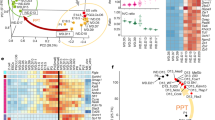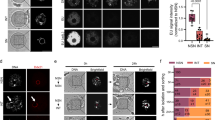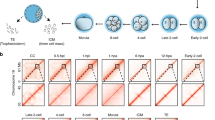Abstract
Enucleated oocytes have the distinctive ability to reprogram somatic nuclei back to totipotency. Here, we investigate genome-scale DNA methylation patterns after nuclear transfer and compare them to the dynamics at fertilization. We identify specific targets for DNA demethylation after nuclear transfer, such as germline-associated promoters, as well as unique limitations that include certain repetitive element classes.
This is a preview of subscription content, access via your institution
Access options
Subscribe to this journal
Receive 12 print issues and online access
$209.00 per year
only $17.42 per issue
Buy this article
- Purchase on Springer Link
- Instant access to full article PDF
Prices may be subject to local taxes which are calculated during checkout


Similar content being viewed by others
Accession codes
References
Reik, W., Dean, W. & Walter, J. Science 293, 1089–1093 (2001).
Rideout, W.M. III., Eggan, K. & Jaenisch, R. Science 293, 1093–1098 (2001).
Wakayama, T., Perry, A.C., Zuccotti, M., Johnson, K.R. & Yanagimachi, R. Nature 394, 369–374 (1998).
Meissner, A. et al. Nature 454, 766–770 (2008).
Smith, Z.D. et al. Nature 484, 339–344 (2012).
Goodier, J.L., Ostertag, E.M., Du, K. & Kazazian, H.H. Jr. Genome Res. 11, 1677–1685 (2001).
Wossidlo, M. et al. EMBO J. 29, 1877–1888 (2010).
Egli, D. et al. Nat. Commun. 2, 488 (2011).
Dean, W. et al. Proc. Natl. Acad. Sci. USA 98, 13734–13738 (2001).
Polanski, Z., Motosugi, N., Tsurumi, C., Hiiragi, T. & Hoffmann, S. Int. J. Dev. Biol. 52, 295–298 (2008).
Ng, R.K. & Gurdon, J.B. Nat. Cell Biol. 10, 102–109 (2008).
Gu, T.P. et al. Nature 477, 606–610 (2011).
Wossidlo, M. et al. Nat. Commun. 2, 241 (2011).
Branco, M.R., Ficz, G. & Reik, W. Nat. Rev. Genet. 13, 7–13 (2011).
Booth, M.J. et al. Science 336, 934–937 (2012).
Acknowledgements
We would like to thank all the members of the Meissner and Regev laboratories. We thank M. Garber, N. Yosef, J. Ye, R. Koche, H. Gu, A. Gnirke and T. Mikkelsen for technical advice and discussion and all members of the Broad Sequencing Platform, in particular, F. Kelley, J. Meldrim, T. Fennel, K. Tibbetts and J. Fostel. We also thank S. Levine, M. Gravina and K. Thai from the MIT BioMicro Center. D.E. is supported by the New York Stem Cell Foundation (NYSCF). A.R. is an investigator of the Merkin Foundation for Stem Cell Research at the Broad Institute and is supported by a US National Institutes of Health (NIH) Pioneer Award (5DP1OD003958), a National Human Genome Research Institute (NHGRI) Centers of Excellence in Genomic Science (CEGS) grant (1P50HG006193), the Burroughs Wellcome Career Award at the Scientific Interface and the Howard Hughes Medical Institute (HHMI). A.M. is supported by the Pew Charitable Trusts, the Human Frontiers Science Program and the NIH (U01ES017155, P01GM099117 and 1P50HG006193).
Author information
Authors and Affiliations
Contributions
M.M.C., Z.D.S., D.E. and A.M. conceived and designed the study. D.E. performed SCNT, Z.D.S. performed methylation profiling, and M.M.C. performed all analysis. M.M.C., Z.D.S., A.R. and A.M. interpreted the data. M.M.C., Z.D.S. and A.M. wrote the manuscript with input from the other authors.
Corresponding author
Ethics declarations
Competing interests
The authors declare no competing financial interests.
Rights and permissions
About this article
Cite this article
Chan, M., Smith, Z., Egli, D. et al. Mouse ooplasm confers context-specific reprogramming capacity. Nat Genet 44, 978–980 (2012). https://doi.org/10.1038/ng.2382
Received:
Accepted:
Published:
Issue Date:
DOI: https://doi.org/10.1038/ng.2382
This article is cited by
-
Transcription factor-mediated direct cellular reprogramming yields cell-type specific DNA methylation signature
Scientific Reports (2023)
-
Global DNA methylation profiles of buffalo (Bubalus bubalis) preimplantation embryos produced by handmade cloning and in vitro fertilization
Scientific Reports (2022)
-
Transcriptional defects and reprogramming barriers in somatic cell nuclear reprogramming as revealed by single-embryo RNA sequencing
BMC Genomics (2018)
-
High Resolution Imaging of DNA Methylation Dynamics using a Zebrafish Reporter
Scientific Reports (2017)
-
Identification of key factors conquering developmental arrest of somatic cell cloned embryos by combining embryo biopsy and single-cell sequencing
Cell Discovery (2016)



